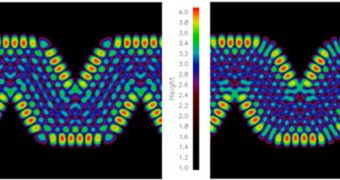The absolute lower limits of miniaturization may not be reached for at least a few more decades, say researchers who recently conducted a study on the properties of graphene nanowiggles. The advanced nanoscale material could soon replace silicon in all electronic equipment.
The issue with silicon is that electronics based on it cannot be miniaturized below a certain threshold. But scientists are already starting to search for possibilities of creating electronics at the atomic scale.
Silicon is unsuited for this, but the hexagonal, bi-dimensional carbon compound graphene may very well be. Usually, the material comes in single-atom-thick sheets, but it can also be fashioned in other shapes, different surface structures called nanowiggles.
With these structures, it may be possible to achieve new levels of performance in the fields of optics, nanoelectronics, and spintronics. The latter is a relatively new field of physics, which deals with finding ways of encoding data in the spin of electrons.
Details of the study appear in a paper entitled Emergence of Atypical Properties in Assembled Graphene Nanoribbons, which is published in the latest issue of the journal Physical Review Letters.
Experts at the Rensselaer Polytechnic Institute (RPI) used the Rensselaer Center for Nanotechnology Innovations' (CCNI) supercomputer to conduct the new study. The model provided a blueprint that scientists can use to pick and choose specific graphene nanostructures.
These structures can be selected based on several factors, such as for example whether or not they are tuned and customized for a different task or device. If so, then the structures appropriate for that particular application can be picked out of the bunch, and then used.
“Graphene nanomaterials have plenty of nice properties, but to date it has been very difficult to build defect-free graphene nanostructures. So these hard-to-reproduce nanostructures created a near insurmountable barrier between innovation and the market,” scientist Vincent Meunier explains.
“The advantage of graphene nanowiggles is that they can easily and quickly be produced very long and clean,” adds the scientist, who is the Gail and Jeffrey L. Kodosky ’70 Constellation professor of physics, information technology, and entrepreneurship at the Institute.
“Without CCNI, these calculations would still be continuing a year later and we would not yet have made this exciting discovery. Clearly this research is an excellent example illustrating the key role of CCNI in predictive fundamental science,” he concludes.

 14 DAY TRIAL //
14 DAY TRIAL //